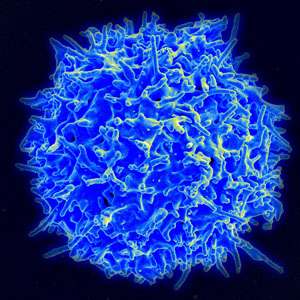Using microRNA fit to a T (cell): Researchers show B cells can deliver potentially therapeutic bits of modified RNA

Researchers at the University of California, San Diego School of Medicine have successfully targeted T lymphocytes – which play a central role in the body's immune response – with another type of white blood cell engineered to synthesize and deliver bits of non-coding RNA or microRNA (miRNA).
The achievement in mice studies, published in this week's online early edition of the Proceedings of the National Academy of Sciences, may be the first step toward using genetically modified miRNA for therapeutic purposes, perhaps most notably in vaccines and cancer treatments, said principal investigator Maurizio Zanetti, MD, professor in the Department of Medicine and director of the Laboratory of Immunology at UC San Diego Moores Cancer Center.
"From a practical standpoint, short non-coding RNA can be used for replacement therapy to introduce miRNA or miRNA mimetics into tissues to restore normal levels that have been reduced by a disease process or to inhibit other miRNA to increase levels of therapeutic proteins," said Zanetti.
"However, the explosive rate at which science has discovered miRNAs to be involved in regulating biological processes has not been matched by progress in the translational arena," Zanetti added. "Very few clinical trials have been launched to date. Part of the problem is that we have not yet identified practical and effective methods to deliver chemically synthesized short non-coding RNA in safe and economically feasible ways."
Zanetti and colleagues transfected primary B lymphocytes, a notably abundant type of white blood cell (about 15 percent of circulating blood) with engineered plasmid DNA (a kind of replicating but non-viral DNA), then showed that the altered B cells targeted T cells in mice when activated by an antigen – a substance that provokes an immune system response.
"This is a level-one demonstration for this new system," said Zanetti. "The next goal will be to address more complex questions, such as regulation of the class of T cells that can be induced during vaccination to maximize their protective value against pathogens or cancer.
"There are reasons to believe that the quality of T cells in response to vaccination matters to the efficacy of protection. This could push vaccination aimed at the induction of T cell responses to a new level of accuracy, predictability and ultimately, efficacy."
Other potential applications, he said, included targeting and repairing T cells disabled by autoimmune or inflammatory diseases.
"Another objective will be to further control targeting to tissues other than lymphoid organs. For example, cancer cells," Zanetti said. "There is a world of untapped possibilities out there. We believe that the new idea – and the technology behind it – will carry a great distance in a variety of conditions to aid regulation of the immune system or control or prevent disease."
More information: Synthesis and delivery of short, noncoding RNA by B lymphocytes, www.pnas.org/cgi/doi/10.1073/pnas.1311145110

















